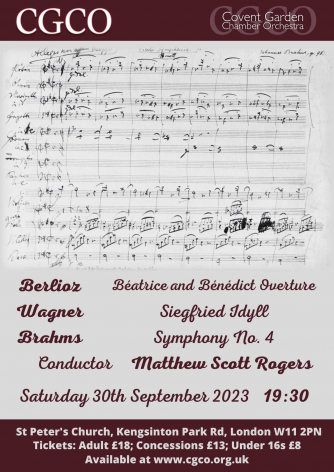Details
St Peter's Church
Kensington Park Road
Notting Hill
London
W11 2PN
England
Programme
Hector Berlioz – Beatrice and Benedict: Overture
Johannes Brahms – Symphony no.4 in E minor, Op.98
Richard Wagner – Siegfried Idyll, WWV 103
Performers
Matthew Scott-Rogers – Conductor
Covent Garden Chamber Orchestra
Programme Note
Kicking off our 2023-2024 season we will be playing three notable works from the 19th Century, including Brahms’ Symphony no. 4, conducted by Matthew Scott Rogers who we welcome back for a second time.
BERLIOZ BÉATRICE ET BÉNÉDICT
Hector Berlioz's delightful opera, Béatrice et Bénédict is based on Shakespeare's play Much Ado About Nothing, and promises to whisk you away on a journey of love, wit, and captivating melodies.
Hector Berlioz, a prominent figure of the Romantic era, composed Béatrice et Bénédict between 1860 and 1862. Inspired by the witty and spirited characters of Beatrice and Benedick from Shakespeare's beloved play, Berlioz weaves a musical tapestry that embraces both joyous themes and contemplative moments.
Set in the idyllic town of Messina, Béatrice et Bénédict explores the entertaining love-hate relationship between the feisty Beatrice and the sharp-witted Benedick. Surrounded by a colourful cast of characters, including Hero, Claudio, and their mischievous friends, this opera revels in mistaken identities, lively banter, and ultimate reconciliations.
WAGNER SIEGFRIED IDYLL OVERTURE
Composed as a gift to his wife, Cosima, on the occasion of their son's birth, this intimate chamber work portrays the tender moments of domestic bliss and the awe-inspiring beauty of nature.
Part I: Dawn
As the performance commences, the orchestra enchants with a shimmering and delicate start, symbolizing the first rays of sunlight at daybreak. The delicate interplay between the strings and woodwinds paints a serene and ethereal soundscape, gently awakening the audience to the beauty of Wagner's creation.
Part II: Love and Lullaby
In this section, the music evolves into a tender expression of love. The lush melodies and gentle crescendos embrace the audience, evoking a sense of affection and warmth. The lullaby-like themes create a sense of tranquility, transporting the listener into the intimate world of Wagner's family life.
Part III: Awakening of Nature
The tone of the piece shifts dramatically as the orchestra portrays the magnificent awakening of nature. Wagner's mastery in orchestrating complex harmonies and seamlessly integrating sections of the orchestra is on full display. The brass section resonates with power, emulating the awe-inspiring forces of nature, while the strings cascade with a sense of grandeur.
Part IV: Joyous Celebration
The final section radiates joy and celebration. Building on the momentum of the previous movements, the orchestra erupts with exuberance, showcasing the full force of Wagner's composition. The intricate harmonies and rhythmical complexity create a sense of awe and wonder, leaving the audience with a lasting impression of Wagner's genius.
Siegfried Idyll is a testament to Wagner's ability to convey deep emotional depth through music. From the serenity of dawn to the turbulent awakening of nature and the joyous celebration that ensues, the orchestra brilliantly captures the essence of this intimate work.
BRAHMS SYMPHONY NO. 4
Brahms' Symphony No. 4 stands as a monumental testament to the composer's mastery of the orchestral form and his ability to weave intricate musical tapestries with profound emotional depth. Written in the late Romantic period, this symphony showcases Brahms' unwavering commitment to craftsmanship and his exploration of profound philosophical themes.
The symphony is structured in four movements, adhering to the traditional symphonic framework but brimming with Brahms' distinctive musical language. The first movement, marked "Allegro non troppo," opens with a solemn, dramatic statement in the cellos and basses, evoking a sense of brooding melancholy. As the movement unfolds, Brahms weaves a series of striking themes and motifs, seamlessly transitioning between moments of turbulence and haunting beauty. The soaring melodies, rich harmonies, and rhythmic complexity captivate the listener, drawing them into a deeply introspective and emotive musical world.
The second movement, "Andante moderato," offers a respite from the intensity of the first. Here, Brahms employs lush and lyrical melodies, delicately orchestrated to create a serene, introspective atmosphere. The music flows gracefully, evoking a sense of longing and introspection. The beauty lies not only in the melodies but also in the exquisite harmonic progressions that underpin the movement, showcasing Brahms' ability to create profound emotional impact through his compositional choices.
The third movement, marked "Allegro giocoso," bursts forth with an exuberant and rhythmic energy. Brahms incorporates elements of folk dance and scherzo-like passages, infusing the movement with a playful and vibrant character. Despite its apparent lightness, the movement reveals moments of depth and complexity, blurring the lines between joy and melancholy. Brahms' masterful orchestration shines through, as he skillfully balances the various instrumental voices, creating a rich tapestry of textures and colours.
The final movement, "Allegro energico e passionato," is a tour de force featuring an unrelenting intensity and dramatic power. From the commanding opening notes to the breathtaking climaxes, Brahms takes the listener on an emotional journey that traverses moments of turbulence, anguish, and triumphant resolve. The symphony's themes and motifs are ingeniously interwoven and developed, leading to a grand and transcendent finale that leaves a lasting impact.
Brahms'

 Your events at Classical Events
Your events at Classical Events

